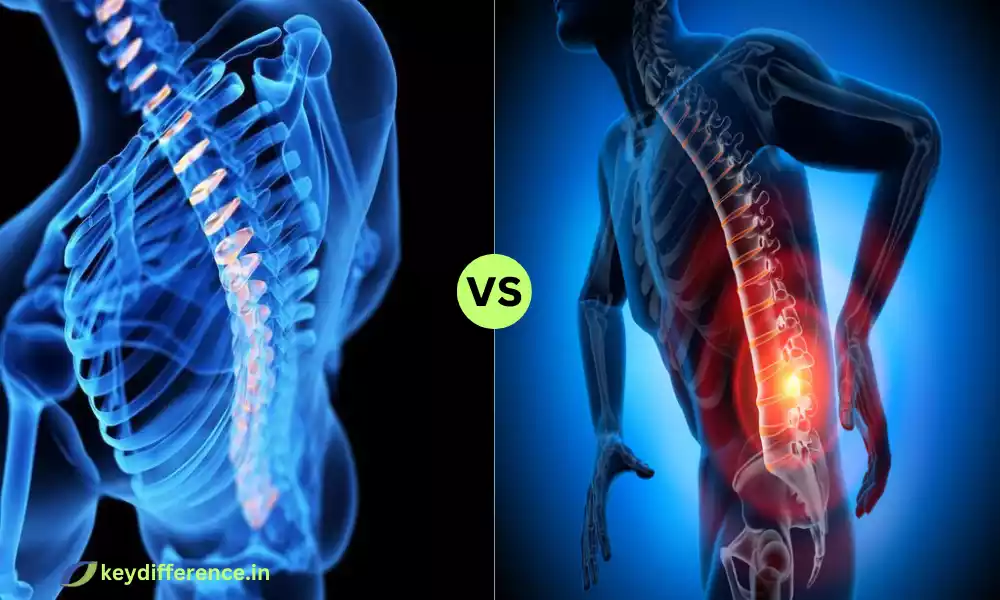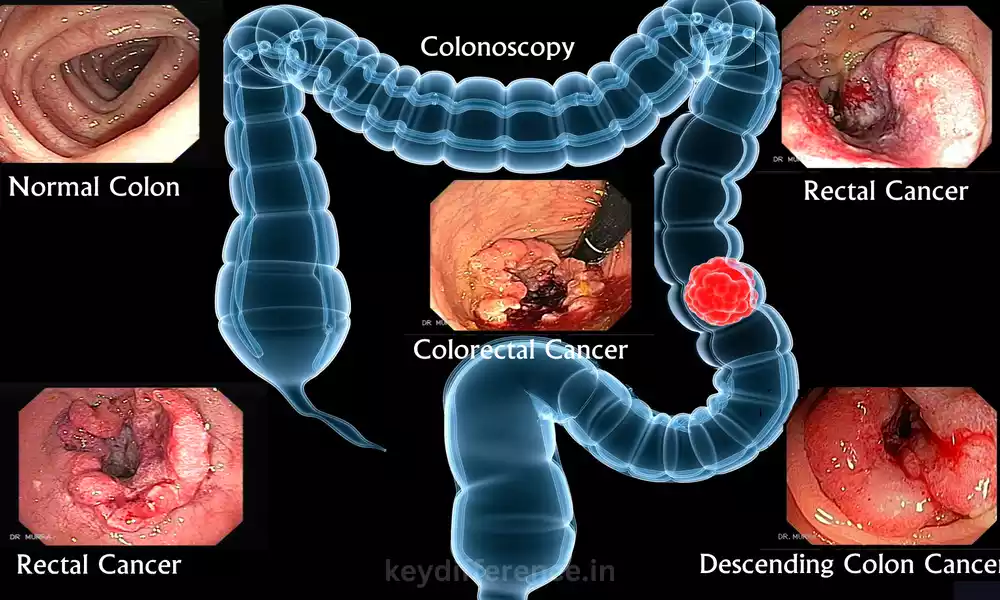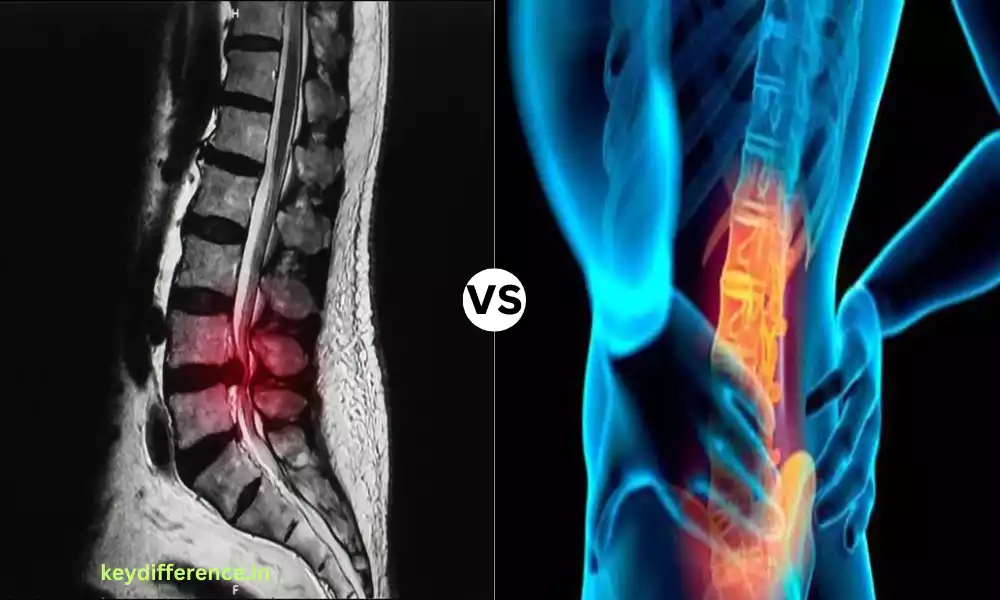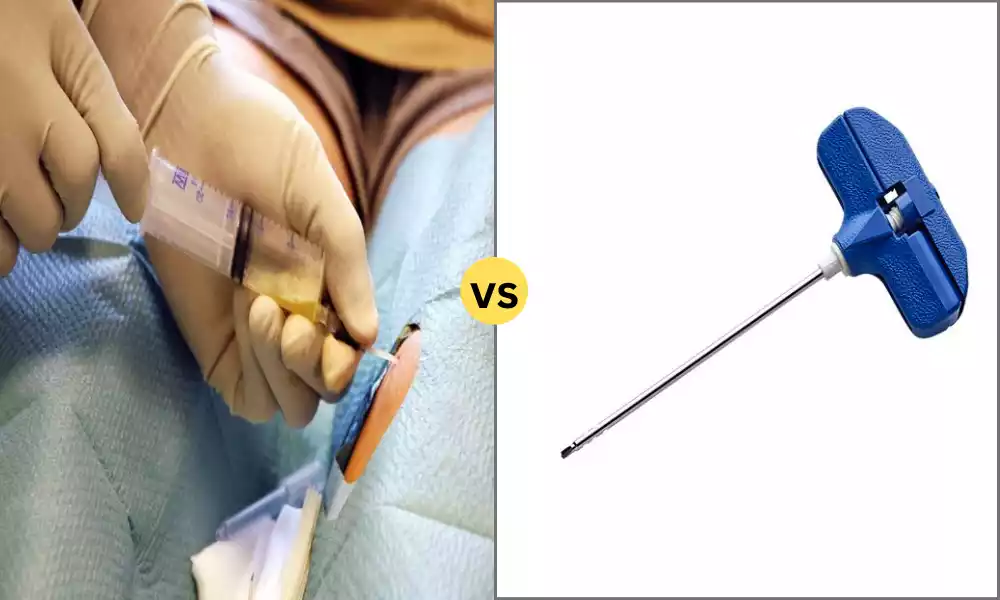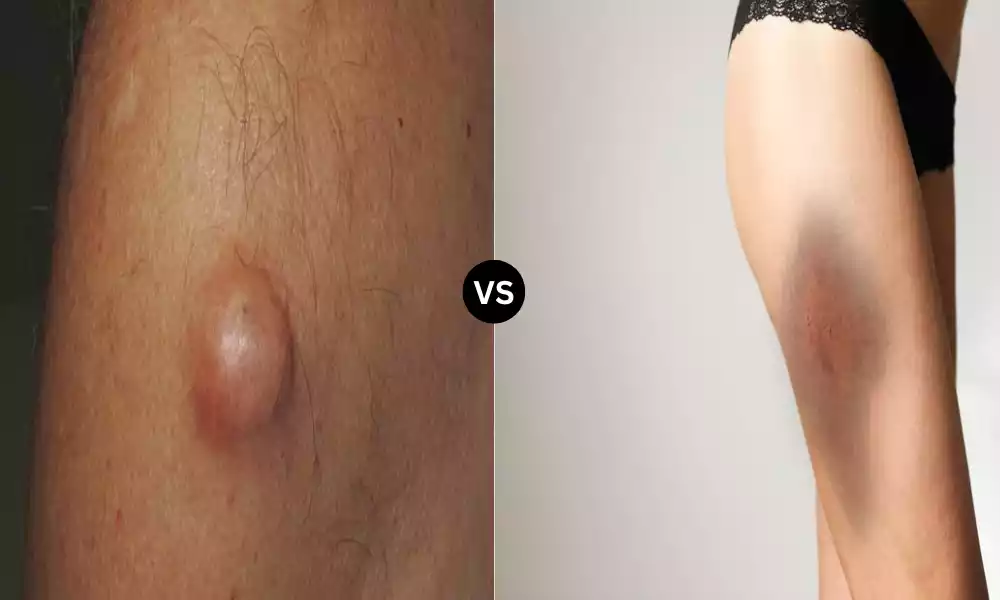Intervertebral discs are essential components of the spine, however, they are also susceptible to many ailments that may create discomfort and impact the overall health of a person.
The most frequent disc-related problems are bulging discs and herniated discs. Knowing the differences between these two conditions is essential to ensure proper diagnosis and treatment.
We will discuss the distinctions between discs that bulge and herniate and their anatomy as well as their causes, symptoms treatment options, and the importance of maintaining the health of your spine to avoid these problems.
Explanation of Herniated Disc
A herniated disc also referred to as a slipped or broken disc condition where the inner soft core (nucleus pulposus) of an intervertebral disk extends out of the hard hard outer skin (annulus fibrous) and presses against nearby spinal nerves or the spinal cord.
The condition may cause different symptoms, including the sensation of tingling, pain, numbness, or an inability to move the affected region, and can happen all over the spine however, it is most often affecting those in the back of the lower (lumbar part of the back) or cervical region. (cervical part of the neck).
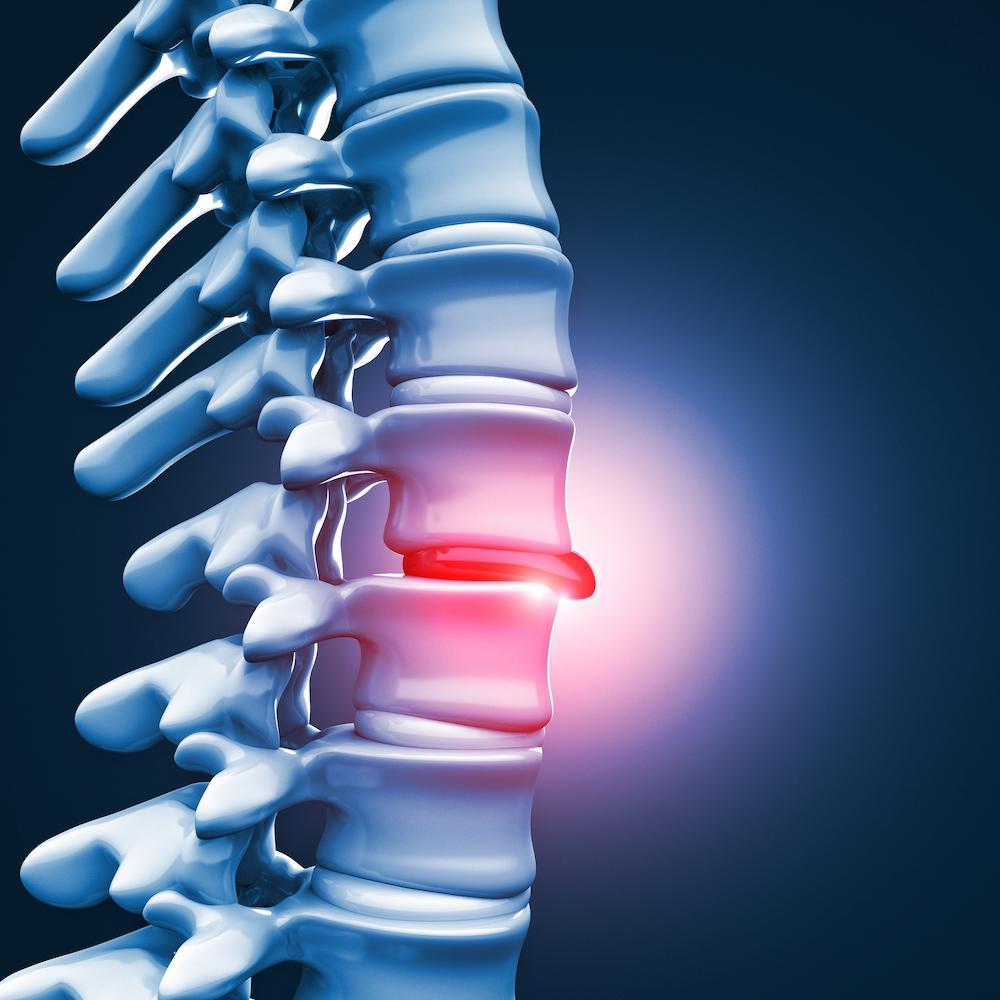
Explanation of Bulging Disc
An elongated disc or bulging disk, commonly referred to as a protruded disk, is a type of spinal disorder where an intervertebral disk extends or protrudes beyond its normal boundaries inside the column of vertebrae.
In contrast to a herniated disc, where the inner layer ruptures by tearing through its outer with a bulging disc it is the outside layer (annulus fibrosus) is not damaged, but it may be stretched or weakened which causes discs to expand or expand outward.
This can place pressure on nearby nerves creating symptoms like discomfort, pain in the local area, or decreased mobility. These discs may bulge anywhere in the spine, but they are most commonly located on the lower part of the back (lumbar area) or the neck (cervical regions).
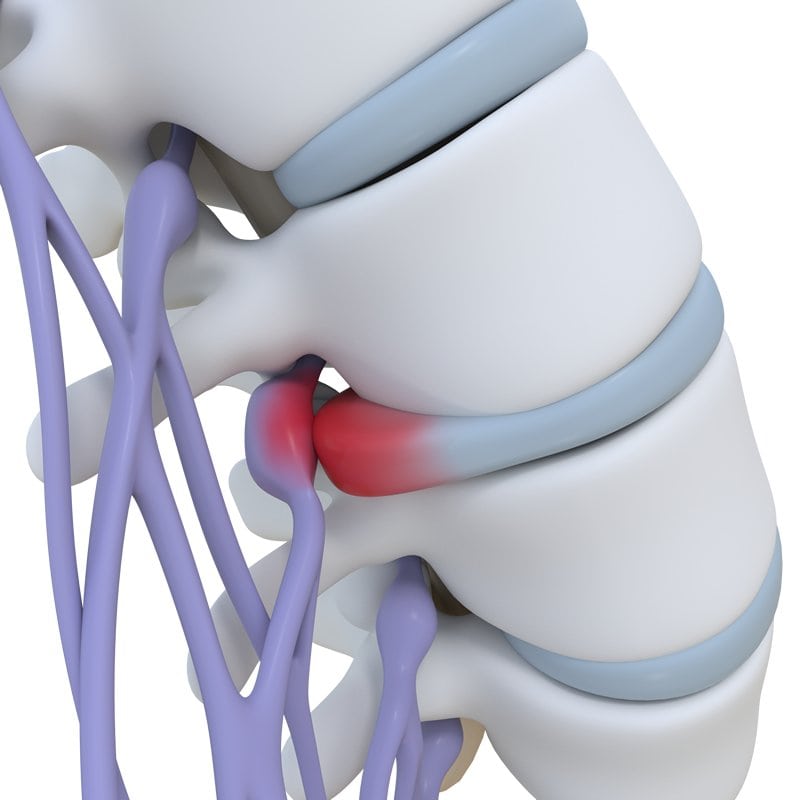
Importance of understanding the difference Between Herniated and Bulging Disc
Knowing the distinction between bulging and herniated discs is crucial for a variety of reasons:
- Accurate Diagnosis:
- The distinction between bulging and herniated discs aids healthcare professionals in making precise diagnoses. A precise diagnosis is essential for creating a successful treatment plan specifically tailored to the individual’s medical condition.
- Treatment Selection:
- The distinction between these two types of ailments determines the range of treatments. Herniated discs usually require more aggressive treatment which may include surgery in more severe cases, while discs that bulge might respond well to more conventional treatments such as exercise and lifestyle changes.
- Management Strategies:
- The knowledge of the specific disc problem will allow healthcare providers and patients to devise appropriate treatment strategies. This could include lifestyle changes as well as exercises and methods for managing pain that are designed to take into consideration the specific characteristics of each condition.
- Prognosis:
- Understanding the distinction between bulging and herniated discs aids the patient and healthcare professionals in assessing the likelihood of recovery. Herniated discs could be more serious and have long-lasting consequences while bulging discs generally have a better outlook when properly managed.
- Risk Assessment:
- Patients suffering from bulging or herniated discs are able to make informed choices regarding their lifestyle and activity decisions in relation to the severity and nature of their problem. Knowing the risks that come with each condition could help avoid the occurrence of an exacerbation.
- Prevention:
- Knowing the difference between these conditions allows individuals to take preventive steps. For instance, adopting the right lifting techniques, keeping an appropriate weight, and maintaining a good posture will lower the chance of disc-related issues.
- Reducing Anxiety:
- Patients who are aware of their illness are typically less worried. A clear understanding of the root of the problem and the treatment options available will reduce fear and anxiety.
- Healthcare Communication:
- Effective communication between healthcare professionals and patients is improved when both parties know the terminology and the nuances of the illness. This facilitates collaboration when developing an effective treatment plan.
Understanding the difference between herniated discs and bulging discs is crucial to making a correct diagnosis, proper treatment options, efficient treatment, and informed decision-making. It allows patients and medical professionals to work towards the most optimal results for spinal health.
Comparison Table of Herniated and Bulging Disc
Here’s a comparison table highlighting the key differences between herniated and bulging discs:
| Characteristic | Herniated Disc | Bulging Disc |
|---|---|---|
| Definition | The soft inner core ruptures through the tough outer layer of the disc. | The outer layer of the disc weakens or stretches, causing the disc to bulge outward. |
| Also Known As | Slipped disc, ruptured disc | Protruded disc |
| Anatomy Affected | Nucleus pulposus and annulus fibrosus | Annulus fibrosus |
| Causes | Sudden trauma, degeneration, lifting injuries | Age-related wear and tear, repetitive stress, poor posture |
| Severity of Symptoms | Often more severe, with the potential for intense pain and neurological symptoms | Generally less severe, with localized pain and discomfort |
| Common Locations | Lower back (lumbar) and neck (cervical) spine | Lower back (lumbar) and neck (cervical) spine |
| Nerve Compression | Common, leading to radiating pain, numbness, tingling, or weakness | Possible, but typically less severe nerve compression symptoms |
| Diagnosis | MRI, CT scan, physical examination | MRI, CT scan, physical examination |
| Treatment Options | Conservative management, physical therapy, epidural injections, surgery | Conservative management, physical therapy, lifestyle changes |
| Surgical Interventions | May be recommended in severe cases or if conservative treatments fail | Rarely required unless complications arise |
| Long-Term Effects | Potential for ongoing pain or neurological deficits if not treated | Generally better prognosis with appropriate management |
| Prevention | Proper lifting techniques, core strengthening, and maintaining a healthy weight | Good posture, regular exercise, avoiding excessive bending or twisting |
Please note that individual cases may vary, and the specific symptoms and treatment options can differ based on the severity and location of the herniated or bulging disc. It’s essential to consult a healthcare professional for an accurate diagnosis and personalized treatment plan.
Anatomy of Intervertebral Discs
The intervertebral discs play an essential role in anatomical structures that are located in between vertebrae on the spinal. They play an essential part in maintaining the flexibility of the spine as well as stability and shock-absorbing abilities.
Here’s a brief overview of the anatomy and function of intervertebral discs:
- Structure of Intervertebral Discs:
- Nucleus pulposus: This central gel-like disc’s core is referred to by the name of nucleus pulposus. It is comprised of collagen fibers, water, and proteoglycans. This gel-like substance gives the disc the ability to absorb the force of shocks and distribute pressure evenly.
- Annulus Fibrosus: Around the nucleus pulposus is the annulus fibrous, which is a strong, flexible outer skin. It is made up consisting of concentric collagen rings that are arranged in alternating directions. They provide durability and stability to the disc. It also acts as a barrier to stop the nucleus pulposus of the disc from expanding beyond its normal boundaries.
- Location Within the Spine:
- Intervertebral discs lie between adjacent vertebrae across the vertebral column from to the cervical (neck) to the lower back to the (lower lower back) regions. They are the main vertebral joints and assist in maintaining the spine’s curvature.
- Function:
- Shock Absorption: Its nucleus pulpous’s high water content permits it to expand and expand, serving like a shock absorption device whenever the spine is exposed to the forces of impact and load.
- Flexibility: These discs allow the spinal column to bend to extend, bend, and twist, which contributes to the mobility and flexibility of the vertebral column.
- Load Distribution: Intervertebral discs equally distribute the load-bearing and weight that are applied to the spine. This reduces stress on the individual vertebrae and helps to improve the stability of the spine.
- Height and Spacing: The discs keep the proper spacing and height between adjacent vertebrae making sure that nerves exiting the spinal cord are given enough space and prevent bone-to-bone contact.
- Blood Supply and Nutrition:
- As with other tissues intervertebral discs have a limited blood supply. They get oxygen and nutrients through an imbibition process which is where the disc’s sponge-like characteristics enable them to pull in liquids once pressure is eased. This is crucial to ensure the health of discs and their repair.
- Age-Related Changes:
- As time passes intervertebral discs experience the natural process of degeneration and wear. The volume of water within the nucleus pulposus decreases, which makes discs less effective shock absorbers. These changes due to age may contribute to disc degeneration which can result in bulging or herniated discs.
Intervertebral discs are intricate structures that play an essential role in the function of the spinal column stabilization, stability, and shock absorption. The understanding of their anatomy is crucial in understanding the state of spinal health and other conditions that affect the spinal column.
Prevention and Lifestyle Considerations
The importance of lifestyle and prevention is essential to maintain spinal health and minimize the risk of diseases like disc herniation or bulging.
Here are some of the most effective ways and habits that people should follow:
- Maintain a Healthy Weight:
- Extra weight places extra stress on the spinal column, especially the area of the lumbar spine. A healthy weight by following eating a balanced diet, and regularly exercising can lower the risk of disc-related problems.
- Practice Good Posture:
- Proper posture is vital for standing, sitting, and lifting. Beware of slouching, rounding your shoulders, or arching your back too much. Workstations and furniture that are ergonomic will also aid in maintaining good posture.
- Exercise Regularly:
- Perform exercises that build your core muscles such as the back and abdominal muscles. A strong core can provide stability to the spine and prevent injury.
- Stay Active:
- Avoid prolonged periods of idleness or sitting for long periods of time. Pause to stretch, stand as well and walk, particularly when you work at work at a desk. Regular activity helps to maintain the health of your spine.
- Use Proper Lifting Techniques:
- When lifting objects, bend your knees and hips and not at your waist. Keep the object near your body and utilize your legs’ power to lift the object instead of putting your back into a strain.
- Avoid Smoking:
- Smoking cigarettes has been associated with decreased spinal blood circulation which may affect the discs’ nutritional status and increase the risk of degeneration.
- Stay Hydrated:
- Hydration needs to be maintained in order to keep the water content in intervertebral discs. Drinking enough water is essential to support healthy discs as well as their functioning.
- Stretch and Flexibility Exercises:
- Include stretching and flexibility exercises in your daily routine to ensure the full range of motion for the spine. It will also help to reduce tension in your muscles.
- Ergonomic Work Environment:
- If you work at work at a desk, ensure that your workplace is designed ergonomically to minimize the strain on your back and neck. Utilize a chair that can be adjusted and a monitor for an ideal posture.
- Healthy Sleeping Habits:
- Make sure you have a comfortable mattress and pillow to keep your spine aligned during sleep. When you lie on your back with a cushion between your knees can lessen strain on your lower back.
- Manage Stress:
- Chronic stress can cause muscular tension and tension and. Use techniques for stress management like meditation, deep breathing, or yoga to unwind your body and mind.
- Avoid Excessive Bending and Twisting:
- Reduce activities that require the excessive twisting or bending of the spine, in particular when lifting large objects.
- Regular Check-ups:
- Make sure you have regular check-ups with your doctor or physical therapist to evaluate your spine’s health and provide instructions on how to maintain it.
- Footwear:
- Select supportive shoes that provide the proper cushioning and arch support to minimize the force on your spine while standing or walking.
Through implementing these prevention and lifestyle guidelines, people can take action to improve their spinal health, decrease the likelihood of disc-related ailments, and ensure overall health.
It is essential to talk with a doctor to get personalized advice and suggestions in accordance with your particular requirements and any existing spinal ailments.
Similarities Between Herniated and Bulging Disc
Herniated discs and bulging discs are both spine ailments that affect intervertebral discs. although they each have their own distinct features, there are a few similarities between them:
- Location: Herniated and bulging discs can be found in a variety of areas in the back, such as those in the cervical (neck) as well as the thoracic (mid-back) and the lumbar (lower back) areas.
- Symptoms: The nature and severity of symptoms might vary, both conditions may cause discomfort, pain as well and limitations to mobility. Both can cause radiating symptoms when nearby nerves are affected.
- Diagnosis: Diagnosis for bulging and herniated discs usually involves imaging tests like magnetic resonance imaging (MRI) or computed tomography (CT) scans and physical examinations that assess neurological signs.
- The Risk Factors: Common risk factors for both conditions are the wear and tear caused by age on discs, repeated strain or strain in the back, as well as bad posture.
- Therapy for Conservatives: In the beginning, both conditions could be managed using conservative treatment strategies. This could include physical therapy, rest, and pain management as well as lifestyle adjustments to relieve symptoms and encourage healing.
- Prognosis: In many cases, the herniated as well as bulging discs can be treated with conservative treatment which can result in relief from symptoms and improved performance.
It is important to remember that despite these similarities herniated discs and bulging discs also differ in the form of the disc’s structural changes along with the degree of discomfort that demand different approaches to the diagnosis as well as treatment.
An accurate diagnosis by a medical expert is vital to determine the exact condition and formulate a suitable treatment program.
The function of spinal discs in spinal movement and shock absorption
The spinal discs, referred to as intervertebral disks, play important functions in the movement of the spine and shock absorption in the vertebral column. These functions are vital to stabilizing the spinal column, its flexibility as well as overall wellness of the spine.
This article will provide a more detailed review of how the discs in the spine help in these functions:
- Spinal Movement:
- Flexibility: These discs, also known as spinal disks, are situated between adjacent vertebrae of the spine. They serve as cushions, allowing the spine to bend to bend, twist, and bend. This flexibility is required to perform various body movements which include bending backward, forward, and sideways, and also for rotational movements.
- Segmental Mobility: The spinal disc divides two vertebral bodies, creating segments of mobility. This means that various parts of the spine are able to be moved independently, which contributes to the spine’s overall flexibility as well as the ability to adapt to different body positions and movements.
- Shock Absorption:
- Load Distribution: The spinal discs are made to take on and distribute the shock and mechanical forces that the spine is exposed to in daily activities. When a person puts weight on the spine, like when walking, standing, or lifting heavy objects, the discs are compressed and evenly spread the load throughout the vertebral column.
- Security of Vertebrae: By absorbing the shock and dispersing loads spinal discs assist in protecting the vertebral body from wear and tear. Without this function of shock absorption and protection, vertebrae are more vulnerable to wear and tear and degeneration.
- Maintaining Spinal Curvature:
- Natural Curves: The spine is naturally curving, which includes those of the cervical (neck) Thoracic (upper back), and the lumbar (lower back) curves. The discs in the spine help maintain those curves, by providing comfort and padding at certain places along the spine.
- Facilitating Nerve Passage:
- The passageway for nerves: Between each vertebral body there is an opening known as the intervertebralforamen. This permits spinal nerves exit from the spinal cord to travel through the body. The discs’ presence can help provide the space needed for these nerves to move through without being squeezed or pinched.
The discs in the spinal column are essential elements of the vertebral spine which allow for spinal movement absorb shocks maintain the curvature of the spine, and also provide a route for spinal nerves.
All of these functions aid in the overall health of the spine mobility, mobility, and protection from mechanical stresses. Care and maintenance for discs in the spinal column are vital for their proper functioning and to prevent issues such as discs that bulge or herniate.
Surgical interventions for severe cases of bulging discs
The surgical treatment for cases of severe bulging discs are generally looked at when other treatments have not provided relief and patients continue to suffer from debilitating symptoms that affect their life quality. The main objective of surgery in such situations is to ease the pressure on the spinal cord and nerves and to improve the stability of the spinal.
Here are some typical procedures to be performed in severe disc bulges:
- Microdiscectomy (Discectomy):
- Method: Microdiscectomy is a minimally surgical procedure that is not invasive. It involves the removal of the part of the disc bulging that presses against the spinal cord or nerves. The surgeon makes a tiny incision using special instruments and a magnifying device to achieve accuracy.
- Signs and symptoms: Microdiscectomy is typically employed to treat hernias of the disc that are contained when the disc’s inner material is not completely ruptured by the layer on top (annulus the fibrosus).
- Laminectomy:
- procedure: A laminectomy involves the removal of the lamina or bony arches that lies at the back of the vertebra affected. The procedure is carried out to open up the spinal canal and relieve the pressure on the nerves as well as spinal cord.
- The indications for this are: Laminectomy is often performed to treat more complex or larger discs with bulges that compress neural structures, or when the spinal canal is narrowed (narrowing of the canals of the spine).
- Spinal Fusion:
- Method: Spinal fusion surgery involves connecting the vertebrae of two or more with bone grafts or rods, screws or cages. The procedure helps stabilize the spine and stops movement between the vertebrae fused.
- The indications are: Spinal fusion may be considered if there’s an underlying instability of the spinal column as a result the removal of the damaged disc. It is typically coupled with discectomy or laminectomy.
- Artificial Disc Replacement:
- procedure: In this surgery the damaged disc can be replaced by artificial disc implants made from metal or a mix of plastic and metal. The goal of this procedure is to keep spinal mobility and address disc-related issues.
- The indications are: Artificial disc replacement is a possibility in select instances in which the preservation of spinal motion is essential, and it could be a viable alternative to traditional fusion surgery.
- Endoscopic Discectomy:
- procedure: Endoscopic discectomy is minimally invasive surgery that utilizes a tiny endoscope and special instruments to take out the herniated or bulging disc material by making a small cut.
- indications: This is an appropriate treatment for certain types of disc bulges, where the herniation can be treated by minimally invasive methods.
- Foraminotomy:
- Method: Foraminotomy involves enlarging the neural foramens, the openings through the spinal nerves that exit the spinal canal. This procedure may help relieve nerve compression caused by an overly bulging disc and bone spurs.
- Indices: Foraminotomy may be done in cases where the bulging disc is leading to nerve root compression when they leave the spine.
The decision to undergo surgery is based on a variety of aspects, such as the particular health of the patient as well as the location and size that the bulging disc is located the presence of any other spine-related problems, and the expertise of the surgeon.
Patients who are considering surgery to treat an extremely bulging disc must consult a specialist in spine to determine the best procedure for their particular situation.
Symptoms and potential complications of herniated discs
Herniated discs, referred to as ruptured or slipped discs, can lead to many signs and possibly complications. These signs are usually caused by the pressure that the herniated disc puts on the spinal nerves or spinal cord. The severity and nature of symptoms may differ based on the position of a herniated disc, as well as the degree that which nerve compression is present.
The most frequent symptoms and possible complications associated with herniated discs are:
- Localized Pain: Herniated discs can trigger localized back pain that is located at the location of the herniation. This type of pain is typically described as stabbing, sharp or radiating.
- Radiating Pain: A primary sign of a herniated disk is a radiating pain that follows the route of the nerve affected. The pain may extend through the back to the buttocks, calves, and thighs as well as the foot or the toes. The exact location of the pain is determined by the position of a herniated disc.
- Tingling and numbness: Herniated discs can cause numbness and sensations of tingling within the areas that are supplied by nerves. Patients might suffer from a loss in sensation or a “pins and needles” feeling.
- Muscle Weakness: Because shearing the disc presses on nerve root this can cause muscles weakness in the respective muscles. The weakness may cause coordination and mobility issues.
- The Bowel, and Bladder Dysfunction: In rare but extreme cases, discs that have herniated within the back of your lower (lumbar area) can cause compression of the cauda equina. It is which is a spinal nerve bundle. The compression may cause problems with the bladder and bowel like difficulty in urinating or managing bowel movements. The situation is medically urgent and needs immediate medical attention.
- Sciatica: The lumbar discs that are herniated can lead to sciatica. This condition is caused by pain that radiates through the sciatic nerve. Sciatica pain can be extremely painful and even debilitating.
- Motor Function Impaired: A severe nerve compression due to a herniated disc could result in impairment of the motor functions in the affected part of the body. This could lead to weakness, muscle atrophy, and difficulties with fine motor abilities.
- Chronic pain: If left untreated or if treatments that are conservative not effective, a herniated disk could cause persistent pain and discomfort and can seriously impact the quality of life of a person.
- Recurrent Hernias: In some cases, discs that have previously been herniated could re-herniate causing the recurrence of symptoms as well as the necessity for further treatment.
- Cauda Equina syndrome (CES): This is a rare, but severe complication of disc herniation in the area of the lumbar spine. The cauda-equina nerves are terribly compressed. It can be accompanied by intense lower back muscle pain, leg weakness feeling of numbness in the groin and bladder, or bowel dysfunction. CES demands immediate medical attention and surgical intervention to stop permanent injury.
It’s important to keep in mind that the herniated discs don’t all result in symptoms. Many patients with herniated discs are able to treat their conditions with conventional treatments like exercise, rest as well and pain medications.
However, for those experiencing chronic or extreme symptoms, consulting with an expert in healthcare or a spinal specialist is crucial to establish the best treatment option, which could involve surgery in certain cases.
Reference Books
Certainly! Here are some reference books on various topics that cover a wide range of subjects:
- Science and Nature:
- “Cosmos” by Carl Sagan
- “A Brief History of Time” by Stephen Hawking
- “The Selfish Gene” by Richard Dawkins
- Literature and Fiction:
- “To Kill a Mockingbird” by Harper Lee
- “1984” by George Orwell
- “The Great Gatsby” by F. Scott Fitzgerald
- Philosophy:
- “Meditations” by Marcus Aurelius
- “The Republic” by Plato
- “Critique of Pure Reason” by Immanuel Kant
- History:
- “A People’s History of the United States” by Howard Zinn
- “The Guns of August” by Barbara W. Tuchman
- “Sapiens: A Brief History of Humankind” by Yuval Noah Harari
- Biography and Memoir:
- “The Diary of a Young Girl” by Anne Frank
- “Steve Jobs” by Walter Isaacson
- “The Autobiography of Malcolm X” by Malcolm X and Alex Haley
- Psychology and Self-Help:
- “Thinking, Fast and Slow” by Daniel Kahneman
- “The Power of Habit” by Charles Duhigg
- “Man’s Search for Meaning” by Viktor E. Frankl
Conclusion
A wide selection of reference books could be an excellent source of knowledge and understanding of various topics. When it comes to exploring the universe with Carl Sagan or studying the complexities of human behavior through Daniel Kahneman, these books provide perspectives, insights, and tales that enhance our lives and expand our perspectives.
It is a timeless and beneficial pursuit, allowing readers to discover the deepest levels of human thought and understanding, as well as science, history, and even creativity. Therefore, whether you’re searching for info or inspiration you should remember there is a vast universe of possibilities that is waiting for exploration.

